终于有人翻译成中文了,呵呵,以后开发更加方便~转载如下:
Functions by category 分类函数
1、Post, Page, Attachment and Bookmarks Functions 文章,页面,附件和链接的函数
get_adjacent_post
返 回 邻 近 的 文 章 的 信 息 数 组 , 详 情 见 :
http://codex.wordpress.org/Function_Reference/get_adjacent_post.
get_children
检 索 附 件 、 版 本 、 子 页 面 等 信 息 , 一 般 情 况 下 由 父 文 章 执 行 , 详 情 见 :
http://codex.wordpress.org/Function_Reference/get_children.
get_extended
获取文章 more 标签分割的数组.$post 是文章的内容
get_next_post
获取下一篇邻近的文章信息.
get_post
返回单篇文章的信息数组或对象,$id 是文章 id,注意这里只能用变量,详情见:
http://codex.wordpress.org/Function_Reference/get_post.
get_post_ancestors
返回基于文章 ID 的父文章的信息数组.
get_post_mime_type
返回基于附件 ID 的方式类型信息.
get_post_status
返回基于文章 ID 的文章状态.
get_post_type
返回基于文章 ID 的文章类型.
�
get_previous_post
返回上一篇邻近的文章信息.
get_posts
获取一系列文章的集合,详情见:http://codex.wordpress.org/Template_Tags/get_posts.
is_post
已弃用.
is_single
判断是否规定的单篇日志.
is_sticky
判断文章是否置顶.
register_post_type
注
册
发
布
情
类
型
,
详
见
:
http://codex.wordpress.org/Function_Reference/register_post_type.
wp_get_recent_posts
返回最近发布的文章数组.
wp_get_single_post
返回单篇文章的的数组或对象,同 get_post().
wp_delete_post
删除文章、页面或附件,$force_delete 为 true 时不经过回收站.
wp_insert_post
发 表 一 片 文 章 或 页 面 , 详 情 见 :
http://codex.wordpress.org/Function_Reference/wp_insert_post.
wp_publish_post
�
通过更改文章状态来发表文章
wp_update_post
更新一篇文章,详情见:http://codex.wordpress.org/Function_Reference/wp_update_post.
get_all_page_ids
返回所有页面的数组.
get_page
返 回 一 个 页 面 的 对 象 或 数 组 , 详 情 见 :
http://codex.wordpress.org/Function_Reference/get_page.
get_page_link
获取页面的链接,$id 是页面 ID,$leavename 判断是否允许使用页面名, $sample 判断
是否示例链接
get_page_by_path
获取一篇基于地址的页面对象或数组,$page_path 是页面地址,$output 指定输出类型是
否对象或数组,默认是对象.
get_page_by_title
获取一篇基于标题的页面对象或数组,$page_title 是页面标题, $output 是输出类型,
默认对象, $post_type 是文章类型,默认 page.
get_page_children
在编号相匹配的页面列表中检索子页面,$page_id 是父页面的 ID,$pages 是被检索的页
面数组.
get_page_hierarchy
返回一个数组,该数组按页面排序次序进行排序,$posts 是页面的集合,$parent 是父 ID.
get_page_uri
获取指定 Id 的页面 uri.
�
get_pages
获取页面的集合,详情见:http://codex.wordpress.org/Function_Reference/get_pages.
is_page
判断是否当前或指定的页面.
page_uri_index
为页面 URI 检索所有页面与附件。检索以页面为父级的文章的附件。
wp_list_pages
输 出 页 面 的 列 表 , $args 详 情 见 :
http://codex.wordpress.org/Template_Tags/wp_list_pages.
add_post_meta
为 指 定 文 章 添 加 自 定 义 ( meta ) 字 段 , 详 情 见 :
http://codex.wordpress.org/Function_Reference/add_post_meta.
delete_post_meta
从 指 定 文 章 中 删 除 含 有 指 定 关 键 字 的 所 有 自 定 义 字 段 , 详 情 见 :
http://codex.wordpress.org/Function_Reference/delete_post_meta.
get_post_custom
返回指定文章的自定义字段.
get_post_custom_keys
获取指定文章的自定义字段名.
get_post_custom_values
获取指定文章的自定义字段名的值.
get_post_meta
返 回 指 定 文 章 中 含 有 指 定 关 键 字 自 定 义 字 段 的 值 , 详 情 见 :
http://codex.wordpress.org/Function_Reference/get_post_meta.
�
update_post_meta
为指定文章更新自定义(meta)字段.
get_attached_file
获取一个附件的地址.$attachment_id 是附件的 ID, $unfiltered 判断是否使用过滤器.
is_attachment
判断附件是否被显示.
is_local_attachment
判断 url 地址是否为本地的附件.
update_attached_file
更新一个附件. $file 是附件地址
wp_attachment_is_image
判断指定的附件是否为图片.
wp_insert_attachment
为 指 定 的 页 面 插 入 一 个 附 件 , 详 情 见 :
http://codex.wordpress.org/Function_Reference/wp_insert_attachment.
wp_delete_attachment
删除指定的附件,$postid 是附件 ID,$force_delete 为 true 时不经过回收站.
wp_get_attachment_image
返回一个附件的 html,$attachment_id 是附件 ID,$size 是(thumbnail, medium, large or
full),$icon 是替代的图标地址.
wp_get_attachment_image_src
返回一个附件的 src,$attachment_id 是附件 ID,$size 是(thumbnail, medium, large or full),
$icon 是替代的图标地址.
wp_get_attachment_metadata
�
返回一个附件的元数据,$post_id 是附件 ID,$unfiltered 判断是否使用过滤器.
wp_get_attachment_thumb_file
获取附件的缩略图地址.
wp_get_attachment_thumb_url
获取附件缩略图地址.
wp_get_attachment_url
获取附件的 url.
wp_check_for_changed_slugs
检查已发表文章中经改动的缩略名并保存原有缩略名.
wp_count_posts
输出文章的统计数组,type 为文章类型,’readable’是可读性.
wp_mime_type_icon
检索 MIME 类型的图标.
wp_update_attachment_metadata
更新指定附件的 MIME 类型.
get_bookmark
获取一个链接的数组. $bookmark 是书签 ID, $output 是输出方式(OBJECT, ARRAY_N, or
ARRAY_A).
get_bookmarks
返 回 书 签 的 数 组 .
详 情 见 :
$args
http://codex.wordpress.org/Function_Reference/get_bookmarks.
wp_list_bookmarks
输 出 书 签 的 数 组 .
$args
详 情 见 :
�
http://codex.wordpress.org/Template_Tags/wp_list_bookmarks.
相关废弃标签: get_links_list() 和 get_links().
wp_get_post_categories
返回文章的类型 ID 数组.
wp_set_post_categories
设置文章分类 ID.
wp_get_post_tags
获取文章的标签 ID.
wp_set_post_tags
设置文章的标签,$tags 是要添加的标签字符串数组,$append 默认为 false 覆盖已有标
签,true 为添加.
wp_get_post_terms
获取文章的分类法数组, 默认是’post_tag’.
wp_set_post_terms
设置文章的分类法,$tags 是要添加的标签字符串数组,$taxonomy 是分类方法,默认’
post_tag’,$append 默认为 false 覆盖已有标签,true 为添加.
add_meta_box
插件开发者可通过该函数在 Write Post,Write Page 和 Write Link 编辑页面内添加版块.
详情见:http://codex.wordpress.org/Function_Reference/add_meta_box.
get_the_ID
返回当前文章的 ID.
get_the_author
获取文章的标签 ID.
get_the_content
�
获取文章的内容,$more_link_text 是更多的链接文字, $stripteaser 在更多内容前显示内
容摘要, $more_file 可选,不使用.
wp_trim_excerpt
必要时为文章生成内容摘要. 摘要应在 55 字以内,如果总字数多于该数目,摘要结尾
应添加字符串’[...]‘。如果少于 55 个字符,显示摘要全文。
2、Category, Tag and Taxonomy Functions 分类、标签和分类法函数
cat_is_ancestor_of
判断$cat1 是否为$cat2 的祖先分类.
get_all_category_ids
返回所有分类的数组.
get_cat_ID
根据分类名获取其 ID.
get_cat_name
分居分类 ID 获取其名称.
get_categories
$args 详 情 见 :
返 回 多 个 分 类 的 数 组 .
http://codex.wordpress.org/Function_Reference/get_categories.
get_category
返回单个分类的详细信息对象或数组。
get_category_by_path
根据地址获取分类的详细信息对象或数组。
get_category_by_slug
根据别名获取分类的详细信息对象或数组。
�
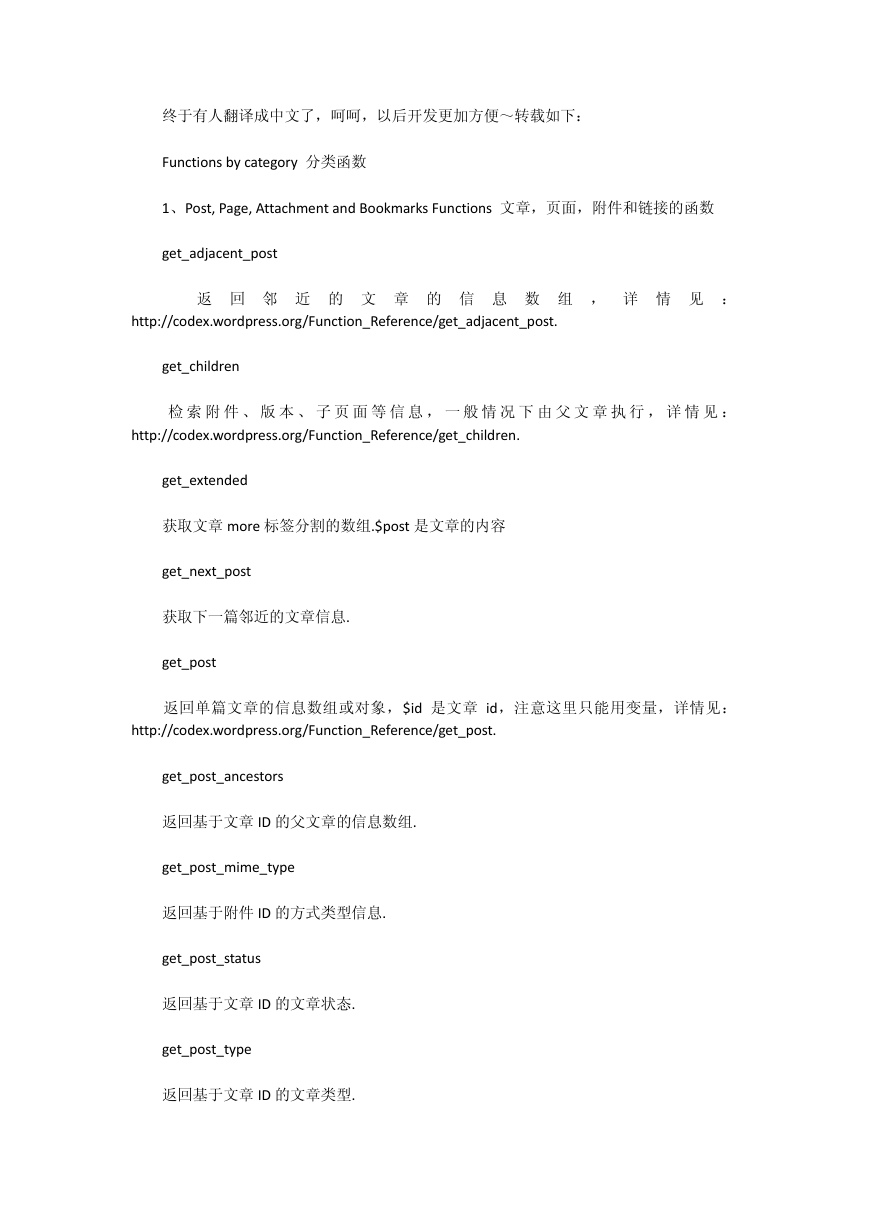
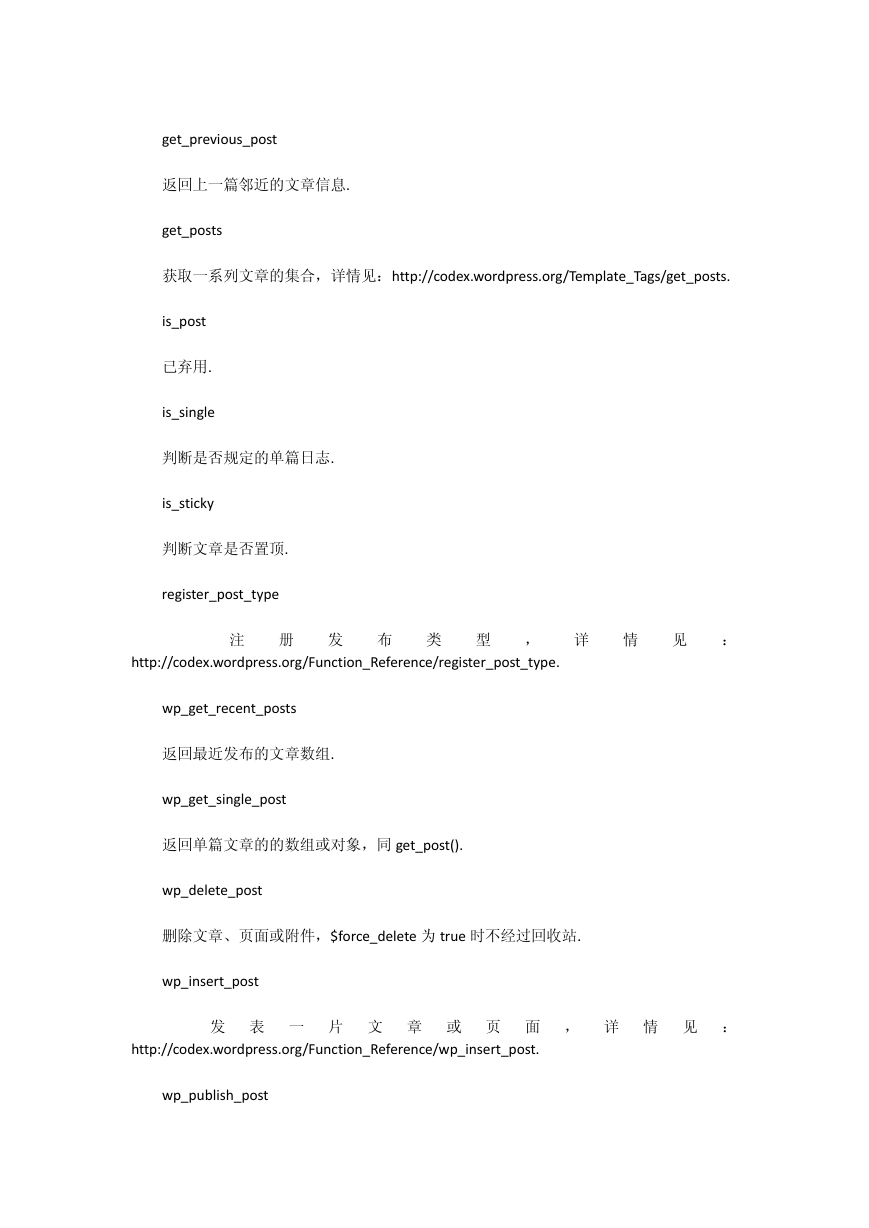
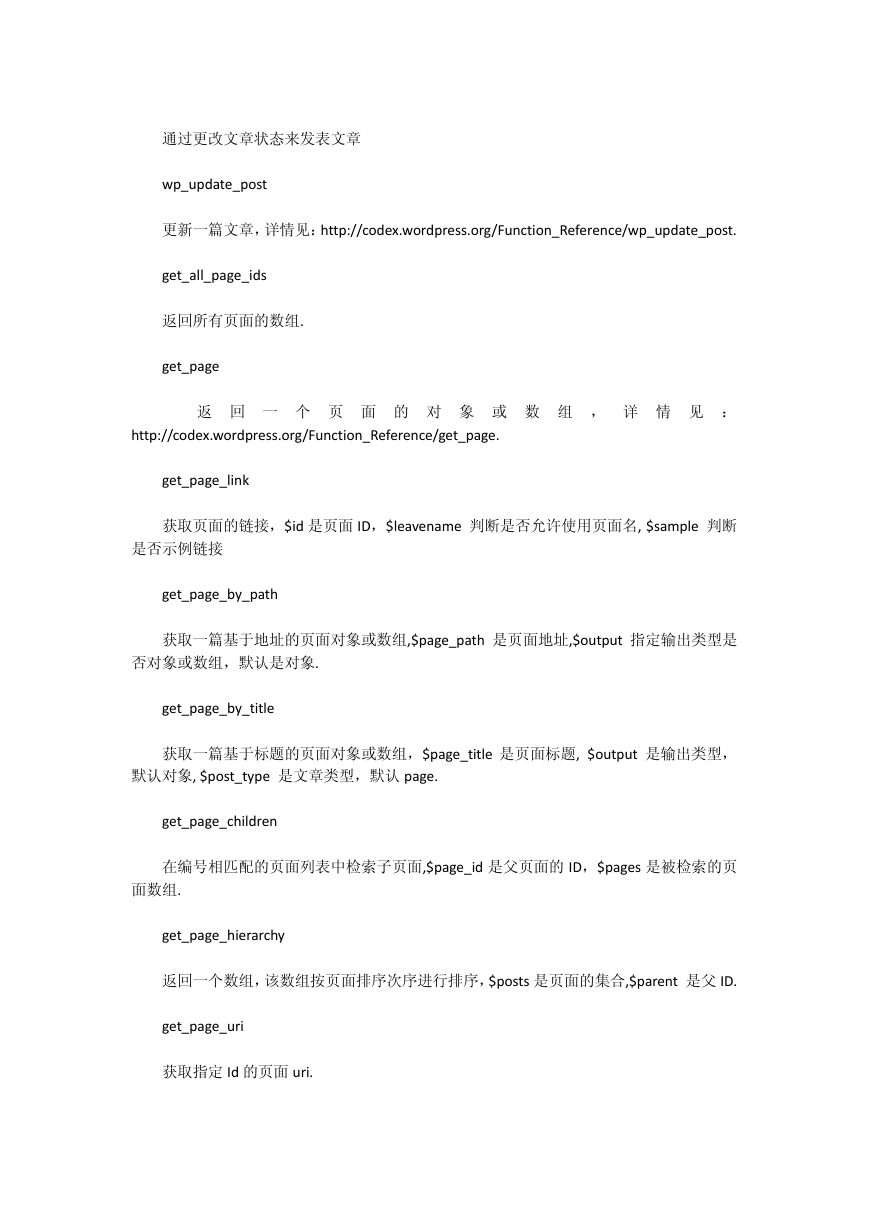
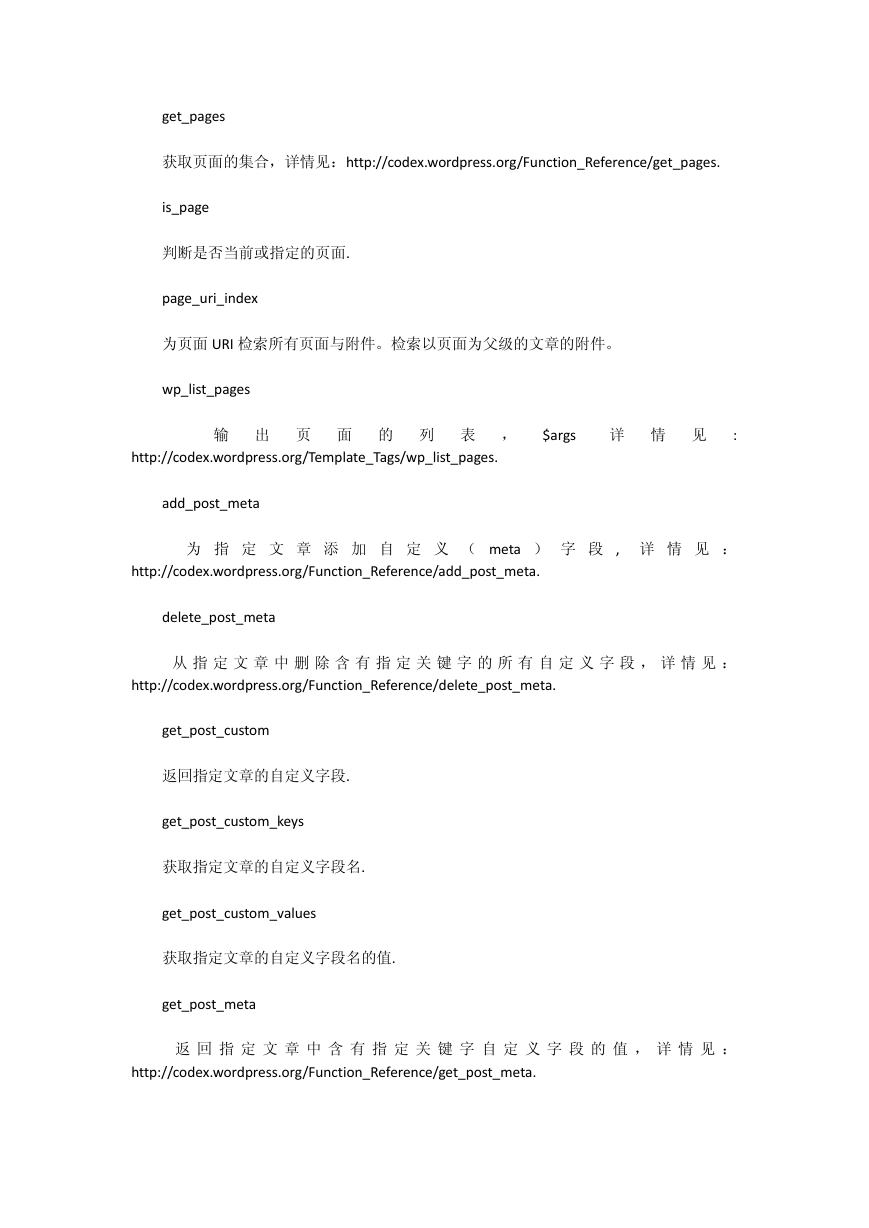
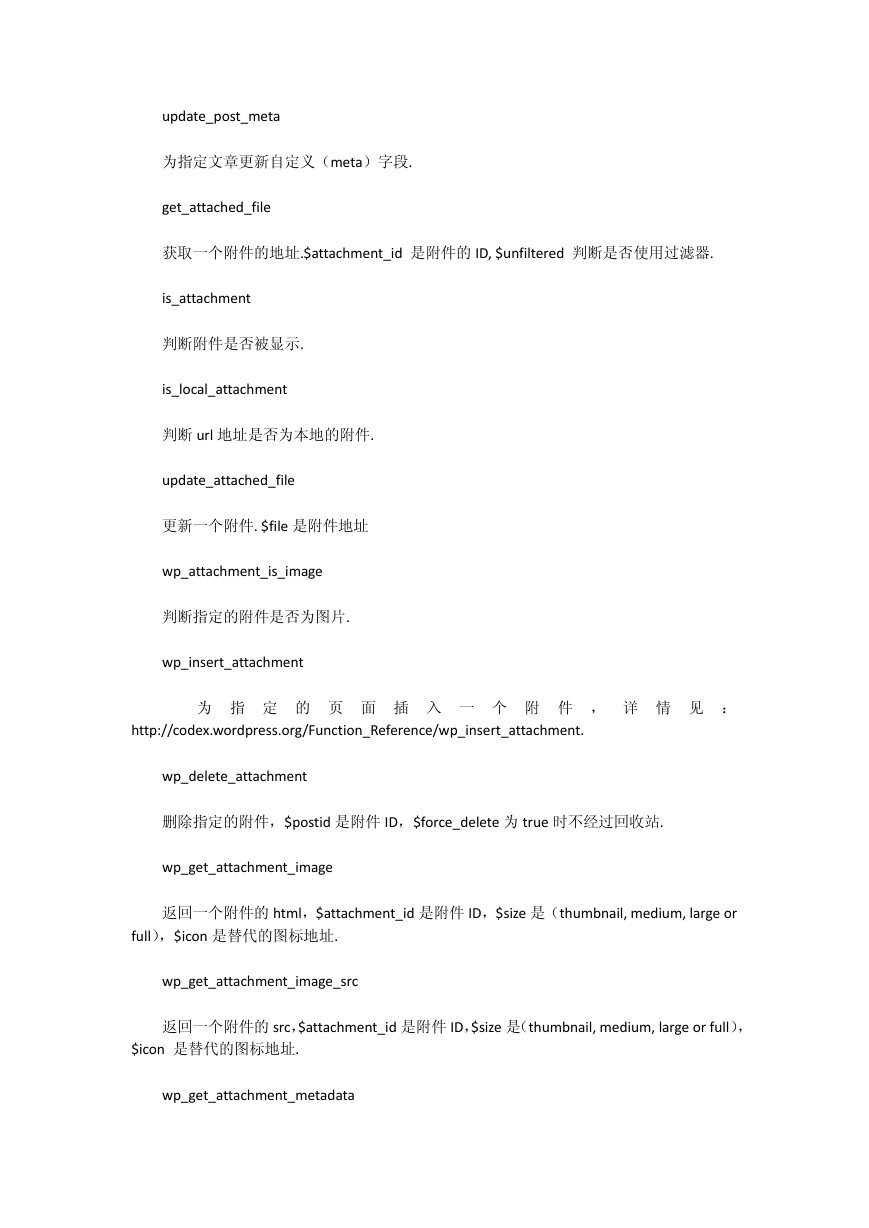
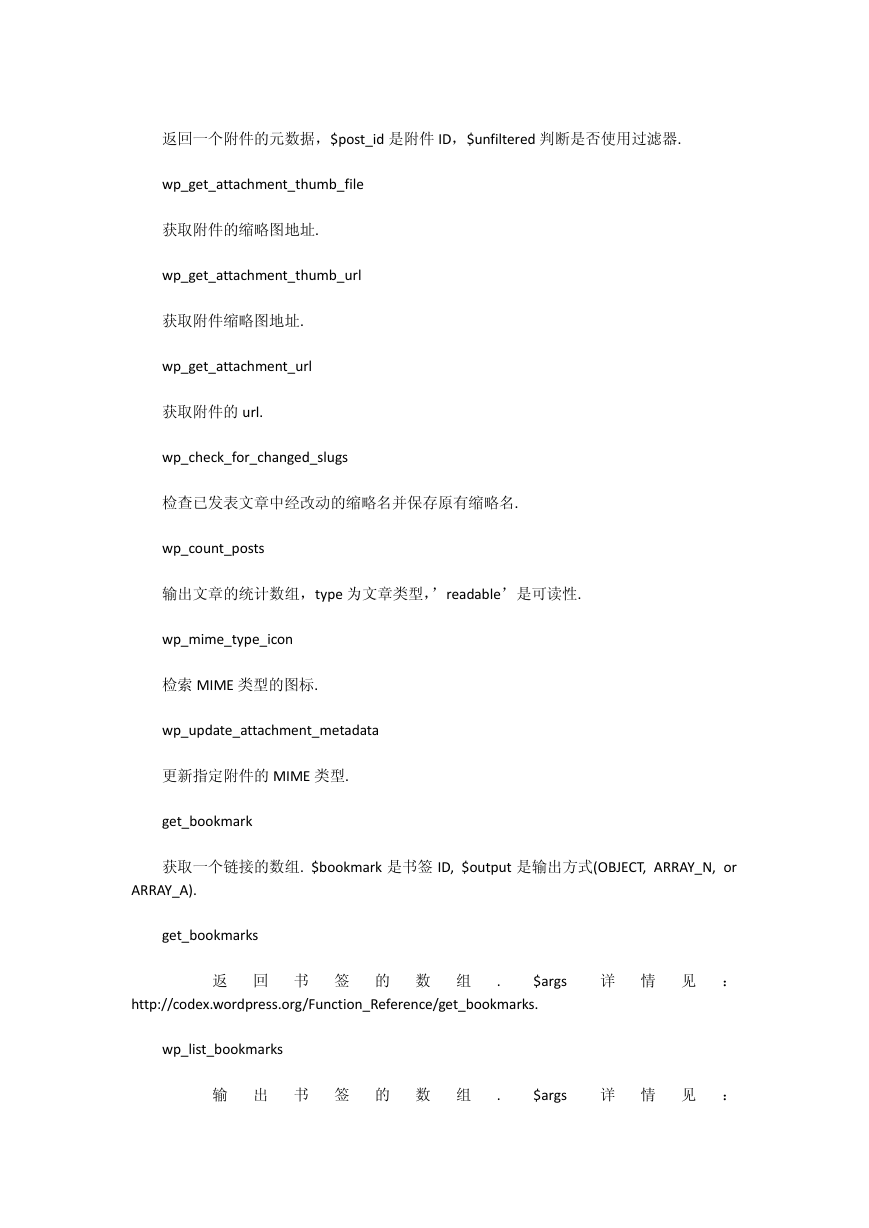
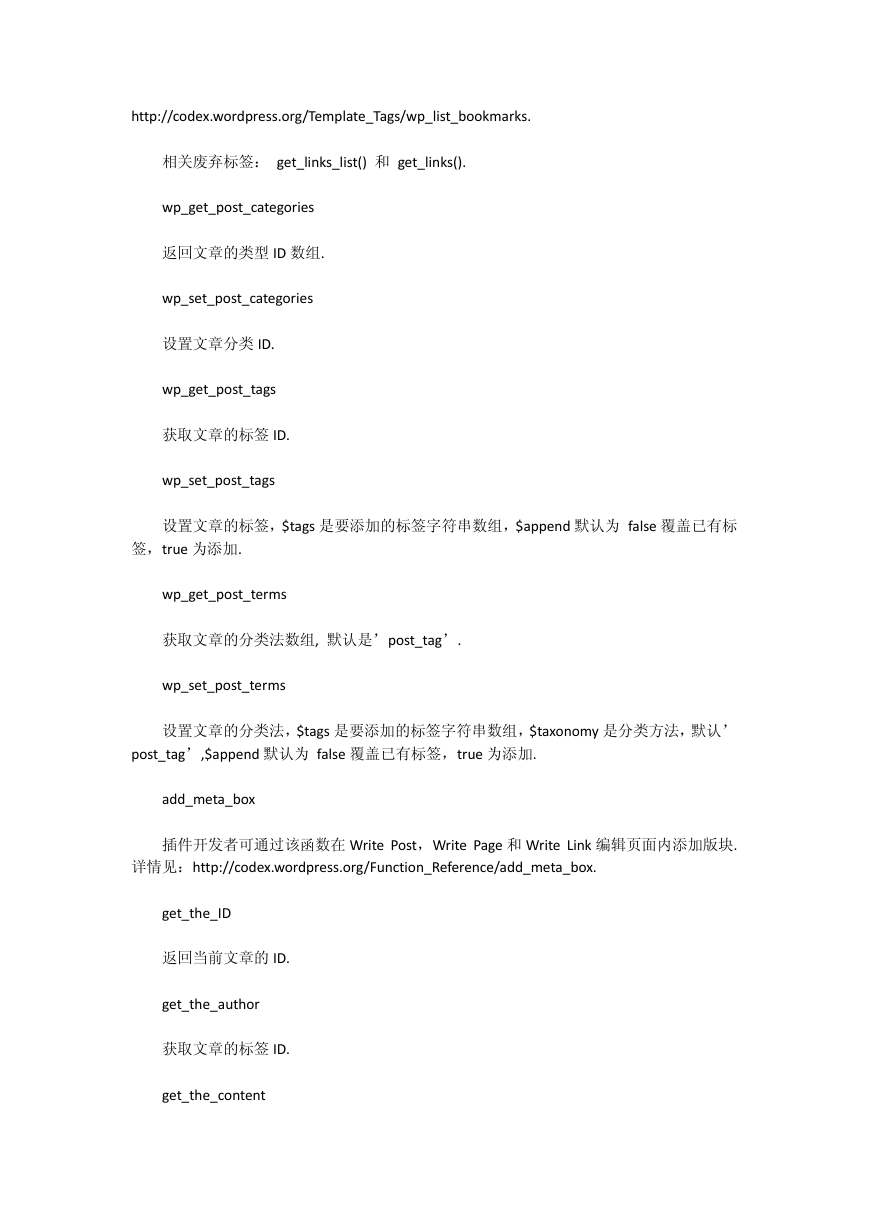
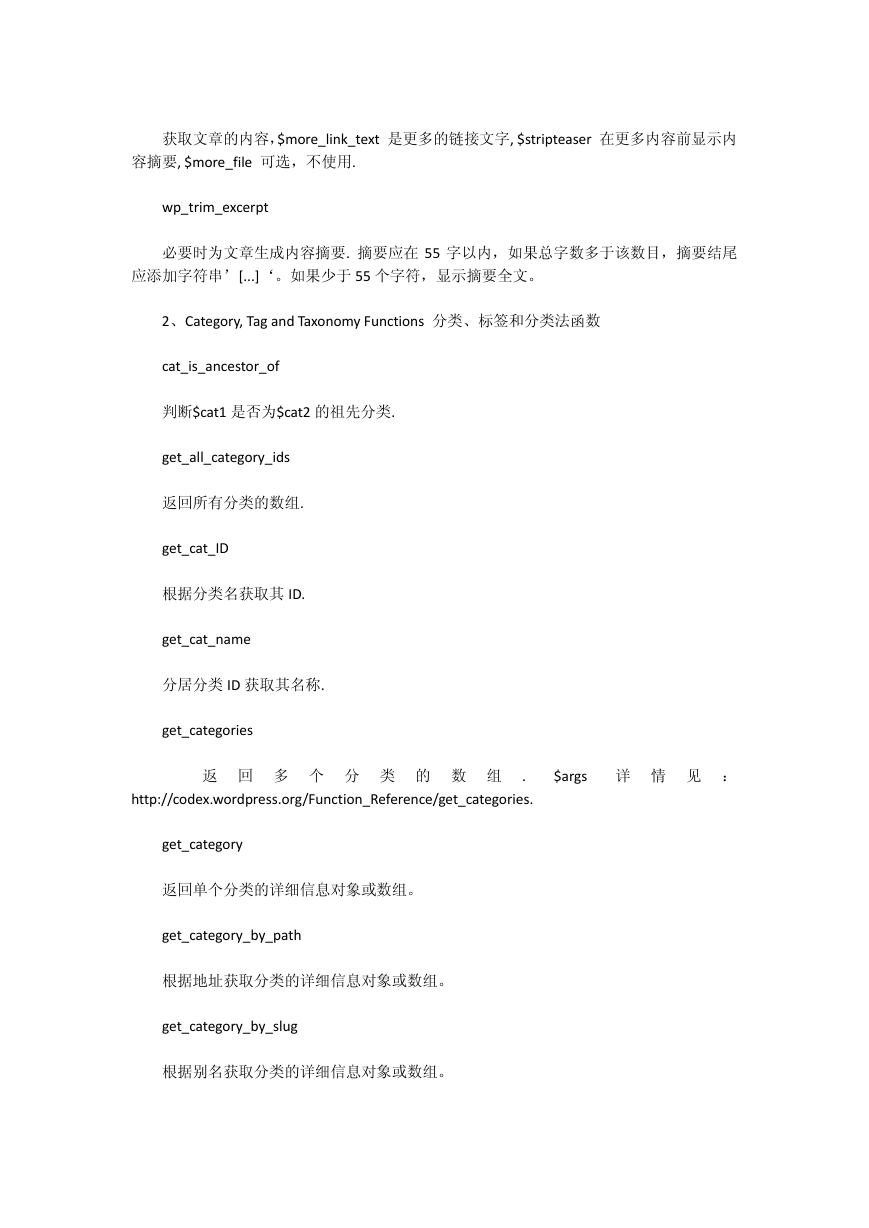








 2023年江西萍乡中考道德与法治真题及答案.doc
2023年江西萍乡中考道德与法治真题及答案.doc 2012年重庆南川中考生物真题及答案.doc
2012年重庆南川中考生物真题及答案.doc 2013年江西师范大学地理学综合及文艺理论基础考研真题.doc
2013年江西师范大学地理学综合及文艺理论基础考研真题.doc 2020年四川甘孜小升初语文真题及答案I卷.doc
2020年四川甘孜小升初语文真题及答案I卷.doc 2020年注册岩土工程师专业基础考试真题及答案.doc
2020年注册岩土工程师专业基础考试真题及答案.doc 2023-2024学年福建省厦门市九年级上学期数学月考试题及答案.doc
2023-2024学年福建省厦门市九年级上学期数学月考试题及答案.doc 2021-2022学年辽宁省沈阳市大东区九年级上学期语文期末试题及答案.doc
2021-2022学年辽宁省沈阳市大东区九年级上学期语文期末试题及答案.doc 2022-2023学年北京东城区初三第一学期物理期末试卷及答案.doc
2022-2023学年北京东城区初三第一学期物理期末试卷及答案.doc 2018上半年江西教师资格初中地理学科知识与教学能力真题及答案.doc
2018上半年江西教师资格初中地理学科知识与教学能力真题及答案.doc 2012年河北国家公务员申论考试真题及答案-省级.doc
2012年河北国家公务员申论考试真题及答案-省级.doc 2020-2021学年江苏省扬州市江都区邵樊片九年级上学期数学第一次质量检测试题及答案.doc
2020-2021学年江苏省扬州市江都区邵樊片九年级上学期数学第一次质量检测试题及答案.doc 2022下半年黑龙江教师资格证中学综合素质真题及答案.doc
2022下半年黑龙江教师资格证中学综合素质真题及答案.doc